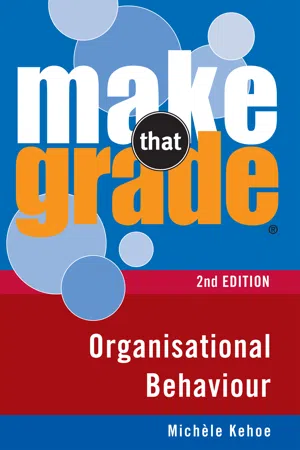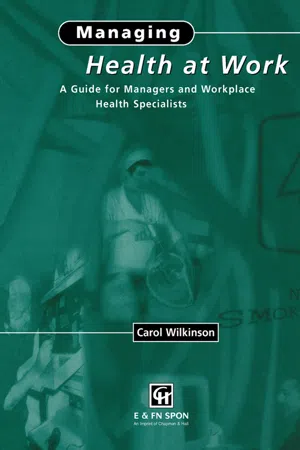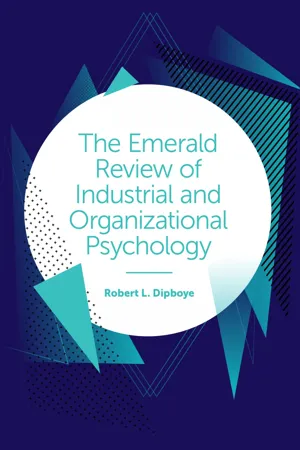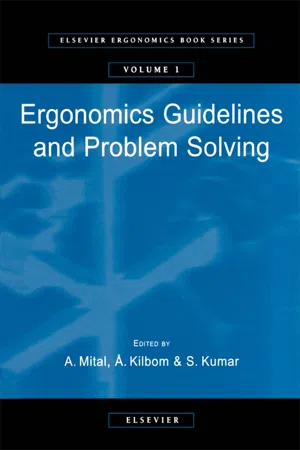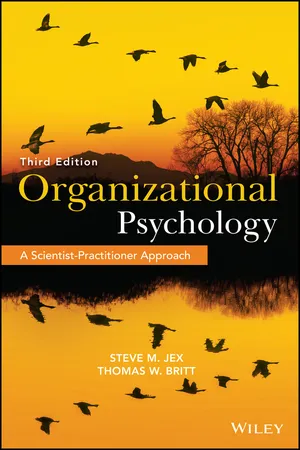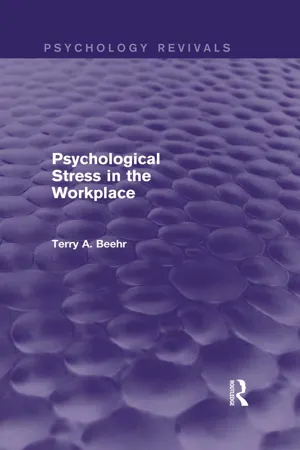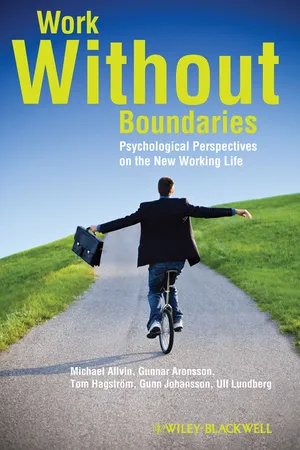Business
Stress in the Workplace
Stress in the workplace refers to the physical, mental, and emotional strain experienced by employees due to work-related factors. Common stressors include heavy workloads, tight deadlines, and interpersonal conflicts. Managing workplace stress is crucial for maintaining employee well-being, productivity, and overall business success. Strategies such as promoting work-life balance, providing support systems, and fostering a positive work environment can help mitigate workplace stress.
Written by Perlego with AI-assistance
Related key terms
Related key terms
1 of 4
Related key terms
1 of 3
11 Key excerpts on "Stress in the Workplace"
- eBook - ePub
- Michele Kehoe(Author)
- 2013(Publication Date)
- Gill Books(Publisher)
6 Stress in the Workplace Objectives This chapter will help you to: Define stress. Describe the General Adaptation Syndrome. Identify the difference between eustress and distress. Characterise Type A and B personality profiles. Examine the causes of life and organisational stressors. Understand the consequences of stress to the individual and the organisation. Recommend individual and organisational coping strategies. 6.1 Stress defined Stress is complex and the experience of it is very individual due to its many causes and consequences. Stress is a reality of life in general and therefore part of the experience of work. The most important aspect of stress is managing it effectively. The benefits for organisations in creating a work environment that helps employees manage the demands of life within and without the workplace include healthier employees, reduced absenteeism, increased productivity and an enhanced reputation. According to Moorhead and Griffin (2012), stress can be defined as ‘ a person’s adaptive response to a stimulus that places excessive psychological or physical demands on that person ’. The source of stress must be perceived by the person to be excessive. Wagner and Hollenbeck (2010) assert that stress is ‘ an unpleasant emotional state ’. Arroba and James (1991) state that stress is ‘ a person’s response to an inappropriate level of pressure. It is a response to pressure, not the pressure itself. ’ This description of stress highlights the fact that stress is caused by pressure from many different sources, such as peer pressure, financial pressure or exam pressure. It is when an individual believes that the pressure they are under is too much for them to handle that stress is experienced. When placed under a lot of pressure, some people experience no stress and others only need a small amount of pressure to suffer the side effects of stress - eBook - ePub
De-Stress at Work
Understanding and Combatting Chronic Stress
- Simon L. Dolan(Author)
- 2023(Publication Date)
- Routledge(Publisher)
- Work context includes career development, status and pay (job insecurity, lack of promotion opportunities, under- or over-promotion, work of low social value, piece rate payment schemes, unclear or unfair performance evaluation systems, being over- or under-skilled for a job); the worker’s role in the organization (unclear role, conflicting roles); interpersonal relationships (inadequate, inconsiderate or unsupportive supervision, poor relationships with colleagues, bullying/harassment and violence, isolated or solitary work, etc.); organizational culture (poor communication, poor leadership, lack of behavioural rule, lack of clarity about organizational objectives, structures and strategies); and work-life balance (conflicting demands of work and home, lack of support for domestic problems at work, lack of support for work problems at home, lack of organizational rules and policies to support work-life balance).
Chapter Summary and Postscript
“Job stress results when the requirements of the job do not match the capabilities, resources or needs of the worker” (NIOSH).12Stress is one of the factors directly responsible for the most common and most lethal psychological and physical illnesses affecting mankind, hence the importance of its study within organizations.There is often confusion between pressure or challenge and stress and sometimes it is used to excuse bad management practice. Pressure at the workplace is unavoidable due to the demands of the contemporary work environment. Pressure perceived as acceptable by an individual, may even keep workers alert, motivated, able to work and learn, depending on the available resources and personal characteristics. However, when that pressure becomes excessive or otherwise unmanageable it leads to stress. Stress can damage workers’ health and his or her business performance.Stress results from a mismatch between the demands and pressures on the person, on the one hand, and their knowledge and abilities, on the other. It challenges their ability to cope with work. This includes not only situations where the pressures of work exceed the worker’s ability to cope but also where the worker’s knowledge and abilities are not sufficiently utilized and that is a problem for them. A healthy job is likely to be one where the pressures on employees are appropriate in relation to their abilities and resources, to the amount of control they have over their work, and to the support they receive from people who matter to them. As health is not merely the absence of disease or infirmity but a positive state of complete physical, mental and social well-being, a healthy working environment is one in which there is not only an absence of harmful conditions but an abundance of health promoting ones. These may include continuous assessment of risks to health, the provision of appropriate information and training on health issues and the availability of health promoting organizational support practices and structures. A healthy work environment is one in which staff have made health and health promotion a priority and part of their working lives. - eBook - ePub
Managing Health at Work
A Guide for Managers and Workplace Health Specialists
- C. Wilkinson(Author)
- 2020(Publication Date)
- CRC Press(Publisher)
2StressWhat is stress?●Defining stress●How does the body react under stress?●Problems of stress at work●Causes of stress●The work environment●The job●The organization●Other causes of stress at work●Recognition and effects of stress at work●Managing organizational stress●Organization of the work environment●Organization of job tasks●Promoting health in the workplace●Management action plan●Guidance for managing stress at work●Individual coping strategies●Work management●Coping with organizational stress●Summary●Suggested further reading●References●Useful addressesWHAT IS STRESS?- Stress covers a wide range of views, thoughts, feelings, body conditions, health, behaviour and work-related issues.
- Stress is a complex phenomenon.
- Stress is a useful concept for the understanding of human functioning and performance.
- Stress is usually regarded as unpleasant, undesirable and unwanted but not always; some stress can have positive effects.
- Stress underlies many common concerns, e.g. anxiety, anger, depression, colds, headaches, boredom, absenteeism.
- Stress is highly individual in its expression.
- Stress occurs when significant internal or external demands are experienced as exceeding available human resources.
DEFINING STRESSStudying stress is for the most part a process which involves observation of behaviour. It is by no means an easy task; as with most processes there are a variety of actions and responses which are not always predictable. However, there are certain characteristics which continue to appear in definitions forwarded by experts in the field: - Robert L. Dipboye(Author)
- 2018(Publication Date)
- Emerald Publishing Limited(Publisher)
As illustrated in these accounts, work stress is increasingly recognized as a serious problem in countries around the world. Perhaps the most serious threat is to mental and physical health. Stress is implicated either directly or indirectly in such life-threatening illnesses as cancer, heart disease, diabetes, cirrhosis of the liver, stomach and intestinal ulcers, arthritis, and lung disease. The most widely consumed prescription drugs treat anxiety, depression, and other symptoms of stress. The widespread acknowledgment of this “stress epidemic” has prompted many people to try jogging, meditation, diets, counseling, support groups, and even new lifestyles. This concern has spread to industry, where business leaders have openly expressed alarm about the spiraling costs their organizations incur from stress-related absenteeism, decreased productivity, and medical expenses. Although it is difficult to estimate the true cost of work stress (see Goldin, 2004), various estimates in the United States range from as high as $300 billion to $50 billion per year. Stress negatively affects the bottom line, but employers also have an ethical and, in some cases, a legal obligation to protect worker health. To deal with the problem, corporations have provided stress management workshops, wellness or health maintenance programs, and exercise facilities. Decreasing employee stress, however, requires an understanding of exactly what it is.Much of the information on stress emanates from its historical roots in medicine and clinical psychology and targets the individual. The spiraling costs to organizations of stress-related outcomes such as illness, injury, absenteeism, and low productivity have compelled researchers to broaden their perspective and take into consideration work and the organization. This chapter is organized into three major sections. The first introduces the concept of stress. The second deals specifically with the sources and outcomes of job-related stress and the characteristics of people that make some more vulnerable than others. The last section is concerned with the management of stress, both at the individual level and organizational level of intervention.Definition of Stress
So, what is stress? Before providing a working definition, I need to correct several popular misconceptions (Selye, 1974). Stress is not something that can or should be eliminated entirely. Many of the most stressful events in your life are the challenges and excitement making life worthwhile. Stress is not simply something occurring in your head to be ignored. Stress has real consequences for mental and physical well-being. Stress is not simply a matter of anxiety or nervous tension you can eliminate by calming your emotions. Stress also consists of physiological reactions that are often unconscious and not controllable. Finally, stress occurs not only as a result of overstimulation and overexcitement but also from boredom and understimulation. Jobs experienced as monotonous and requiring long periods of inaction are often just as stressful as dangerous or exhilarating jobs.- eBook - ePub
- A. Mital, Å. Kilbom, S. Kumar(Authors)
- 2000(Publication Date)
- Elsevier Science(Publisher)
Managing Stress in the Workplace: Part II – The scientific basis (knowledge base) for the guide
Ann M. Williamson, National Institute for Occupational Health and Safety (Worksafe Australia), P.O. Box 58, Sydney, Australia 20011. Problem description
The stress response is the body’s natural reaction to situations that are perceived to require more than the normal or comfortable amount of effort to achieve required performance. Situations that are unfamiliar to the individual or that challenge or threaten them in some way will produce a stress response. One of the pioneers of the area of stress, Hans Selye, described stress in terms of the nonspecific result of any demand made on the body (Selye, 1936 , 1982 ). This could include situations that are well-recognised to produce a stress response in individuals not used to them, like having to speak in public, taking on a new or difficult task, or undergoing examination or inspection. In all of these situations the physiological, psychological and behavioural changes that form the stress response have beneficial effects on performance. Biochemical and other changes help to, amongst other things, increase the level of energy and muscle tension of the individual and improve their ability to concentrate on the task at hand, thereby helping to enhance their performance. A certain level of stress that brings about these sorts of changes is a necessary aspect of maintaining productivity.A very large amount has been written about when stress occurs, and many theories and models have been developed (Eichler et al., 1986 ; Kahn and Byosiere, 1992 ). This is an important issue because the model which describes when stress occurs will provide the framework for all other work on the problem, including how it is prevented and managed. The earlier models of stress emphasised the biological processes involved and described stress as occurring when the body state changed in response to external demands (Cannon, 1935 ; Selye, 1936 , 1982 ). Later models emphasised the interaction between the environment or situation (stressors) and the person, for example the Person–Environment Fit model (French et al., 1982 ) or the job demands and control model (Karasek, 1979 ). More recent models have been based on the same person-environment relationship but have focussed on different features. For example some models have emphasised the transactional or process-oriented nature of the relationship between the person and their environment (Lazarus and Folkman, 1984 ; Cox, 1978 ), and others have included the role of moderating or mediating factors like age, education and the amount of social support in the person-environment relationship in addition to the other acknowledged factors (Ivancevich and Matteson, 1980 ; Kahn and Byosiere, 1992 - eBook - ePub
The Psychology of Behaviour at Work
The Individual in the Organization
- Adrian Furnham(Author)
- 2012(Publication Date)
- Psychology Press(Publisher)
7 Stress at workIntroductionAll jobs are potentially stressful, although the stresses vary widely. Some jobs are incredibly boring, involving machine monitoring or property guarding, and others are over-stimulating and physically demanding, leading to exhaustion. Stress is certainly pervasive. In a recent study of the 147 million workers in the European Union, 30% complained of backache, 28% of stress, 20% of fatigue, 17% of muscular pains and 13% of headaches (Paoli, 1997). There is certainly nothing new about either the acuity or chronicity of work stress, except perhaps the rapid rise in the number of people claiming to be stressed. Due to the popularity of the idea, and thanks to saturated media coverage, most people have learned to recognize classic symptoms: changes in eating, drinking, smoking patterns; irritability and moodiness; absent-mindedness, tiredness and exhaustion; anxiety and depression; negativism and susceptibility to illness.The word “stress” is derived from the Latin word stringere, which means “to draw tight” (Cox, 1978). It is such an overused and elusive term that many have agreed it should be completely abandoned. Many definitions exist: some believe stress can and should be subjectively defined; others feel one needs an objective definition. Some researchers believe a global definition is appropriate; others emphasize that stress is multidimensional. Until the eighteenth century, it colloquially implied hardship, adversity or affliction. It was later used by physicists to describe a force exerted upon an object, so that resultant changes in volume, shape and size were called “strains”. Hence, “stresses and strains”.Sometimes a concept becomes so oversized and extended it becomes meaningless. That happened to “alienation” for sociology and “neurosis” for psychiatry. Is the same true for stress? It has been seen as a confounding, dependent, epiphenomenal, independent, intervening and moderating variable. Briner (1999) has put forward a good case for abandoning the concept in favour of “feeling/emotions at work”. He notes quite correctly that stress is both stimulus and response. It is, at one and the same time, thought of as cause and consequence, trait and coping style, biological phenomenon and disrupter of performance. Because of this terminal confusion, the research is often bad. Even more provocatively, Briner (1999) believes that stress is a modern myth because the better the research, the more the evidence for the relationship between work stress and personal reactions evaporates. - eBook - ePub
Organizational Psychology
A Scientist-Practitioner Approach
- Steve M. Jex, Thomas W. Britt(Authors)
- 2014(Publication Date)
- Wiley(Publisher)
Chapter 7 Occupational Stress and Employee Health and Well-BeingOccupational stress is a topic that has generated a tremendous volume of research (Beehr, 1995; Jex, 1998), and a great deal of that research has focused on the physical and mental health of employees (Tetrick & Quick, 2011). Stress is also a topic that has been the focus of a great deal of popular media attention, and it comes up frequently in everyday conversation. (Who doesn't have a stressful job!) Despite all this attention, the scientific study of occupational stress does not have a long history. Furthermore, despite the considerable progress that has been made over the years, we still have much to learn about the impact of stress on the health and well-being of employees.A question that is often asked about occupational stress is: Does it really have an aversive effect on individuals and organizations, or are those who study occupational stress “making mountains out of molehills”? There is evidence that being consistently exposed to stressful work conditions is harmful to employees and may have a negative impact on organizational effectiveness. Consider, for example, that the amount of money extracted from the U.S. economy due to occupational stress has been estimated to be in the billions of dollars (e.g., Aldred, 1994; Ivancevich & Matteson, 1980; Matteson & Ivancevich, 1987; Mulcahy, 1991). Such estimates are based on the assumption that stress plays a role in negative outcomes such as increased healthcare costs, higher rates of absenteeism and turnover, more on-the-job accidents, and reduced productivity.Another indication of the harmful effects of occupational stress is the increasing trend toward stress-related workers' compensation claims (DeFrank & Ivancevich, 1998; National Council on Compensation Insurance, 1988 1991). In the past, compensation for work-related injuries was limited to physical injuries caused by some physical event or stimulus. Increasingly, however, more and more states are recognizing the legitimacy of physical and even psychological injuries that may be caused by some stressful aspect of the work environment that is not physical in nature (e.g., an overly demanding supervisor). In fact, a trend in recent research is to examine the intersection between psychological and physical risk factors in the prediction of both psychological outcomes (e.g., depression, burnout) and such physical outcomes as accidents (Kaplan & Tetrick, 2011). - Rabi S. Bhagat, James Segovis, Terry Nelson(Authors)
- 2016(Publication Date)
- Routledge(Publisher)
Work-Family InterfaceAlthough conflict between work and family has been a major source of stressors for many employees prior to 1970, this issue has begun to generate substantial interest during recent years. There has been a significant increase in the families in which all of the adults work for pay (Bianchi & Raley, 2003; Jacobs & Gerson, 2001). In 1970 about 36% of married couples between the ages 18 and 64 were composed of two earners, but this figure rose to over 70% in 2008. This trend, while not as common in non-Western countries, is slowly emerging in the Eastern and developing world. The proportion of single parents who are employed increased from 53% in 1970 to over 71% in 2010. These demographic changes in the United States, Western Europe, and other parts of the globalizing world have major consequences in the development of new patterns of work stress. The implications for coping are also likely to be quite different from the ones that have been studied in the context of work stress. In addition, work- and organizational-related changes that occur as a result of global competition create pressures for more working hours, which intensify work—family conflict.Incorporating Ethnic, Social, and Cultural Variations
As globalization expands across nations and cultures, people of dissimilar values, practices, habits, and norms come in contact as customers, employees, and managers, and in other roles. Cross-cultural and cross-national research on work stress is of growing importance in this era of globalization. For example, Japanese managers of the subsidiary of a large global company such as Toyota Incorporated located in the United States need to understand the role of work and societal cultures to develop better human resources practices. Similarly, managers from U.S. global national companies need to develop better insights into the importance of culture, religion, and local values and mores in managing call centers and outsourcing operations in India, where cultural patterns differ considerably from those of the United States. Research on cultural variations that are applicable to various nations and cultures has grown tremendously since Hofstedes classic study in the 1980s (Hofstede, 1980). It is important for work stress researchers to incor-porate the insights from these theoretical models in advancing the role of ethnic, societal, and cultural variations in work stress and coping-related processes.- No longer available |Learn more
- Charles Abraham, Mark Conner, Fiona Jones, Daryl O'Connor(Authors)
- 2016(Publication Date)
- Routledge(Publisher)
4 Stress and health in context
DOI: 10.4324/9781315776453-6Chapter Plan
Chapter 3 examined a range of different approaches to stress and considered the links between stress and health. In this chapter we look at the effect of environmental or contextual factors on stress and their relationship to health.In the first section, we consider the effect of socio-economic status (SES) and social inequality on stress and health. It is well established worldwide that poverty and deprivation are associated with poor health and that even within affluent societies lower SES is linked to poorer health. We consider the role of stress in this relationship.We then consider stress at work in a subsequent section. For most people, their job determines their income and therefore their SES. Indeed, researchers typically classify individuals into social classes based on their occupation using formal classification systems such as the UK National Statistics Socio-Economic Classification (NS-SEC; National Statistics, 2002). Most people spend a significant proportion of their lives at work and evidence suggests that many people feel that it is a major source of stress (Smith et al., 2000 ). Work stress is also of great interest to employers who need to have healthy and productive workforces.Work stress is also known to have implications beyond the work environment. If we feel stress at work this cannot always be easily switched off when we go home and similarly major problems in our personal lives may affect our work. Work stressors may impact even more on our home lives if we work long hours and take work home with us. Increasingly, the barriers between work and home are being eroded by new technology and changing working patterns (Major and Germano, 2006 - Terry Beehr(Author)
- 2014(Publication Date)
- Routledge(Publisher)
Kahn and Byosiere, 1992 ). Strains are states that are harmful and usually aversive to the individuals experiencing them. In the present language, the strains to individuals are the outcomes that define Stress in the Workplace and they are usually states associated with ill health, broadly defined. These outcomes can be divided into three categories: psychological, physical or physiological, and behavioral. These correspond roughly to (poor) mental health, (poor) physical health, and behaviors likely to be deleterious to one’s own health and well-being.Beehr and Newman (1978) named several psychological health consequences or psychological strains that had been studied in conjunction with the kind of occupational stress of interest here, but they were able to cite very few instances of published empirical relationships between occupational stressors and physical health consequences and behavioral strains. Much research has been done since that time, but the pattern of emphasis on psychological strains in relation to social psychological Stress in the Workplace has persisted. No doubt many I/O psychologists think of the difficulty of measuring physical reactions to work in terms similar to Scott’s (1966) quote at the beginning of the chapter.Psychological Strains
A meta-analysis focusing on the two classic role stressors, role conflict and role ambiguity, illustrates the emphasis of workplace stress researchers on psychological strains very well. Eleven of the fifteen outcomes examined were psychological or emotional strains (Jackson and Schüler, 1985). In addition, as noted by Jex and Beehr (1991), the relationships between the types of work stressors that organizational psychologists study and psychological strains are stronger than the relationships between these stressors and other types of strains.Individual outcomes such as anxiety, depression, and dissatisfaction are often associated with occupational stressors (Beehr, 1985a ). Somatic complaints could be considered a physical or physiological strain, but even they are often measured by self-reports of aches and pains rather than anything more objective and concrete (Jex and Beehr, 1991). Furthermore, similar items are often found in anxiety scales (e.g. Taylor Manifest Anxiety Scale; Taylor, 1953- eBook - ePub
Work Without Boundaries
Psychological Perspectives on the New Working Life
- Michael Allvin, Gunnar Aronsson, Tom Hagström, Gunn Johansson, Ulf Lundberg(Authors)
- 2011(Publication Date)
- Wiley(Publisher)
In this passage, we have discussed various stress models relating to the development of society and work life. The purpose of this has not been merely to give an introduction to stress as a concept and area of research, but also to show how the concept is constantly shaped and reshaped in connection with the historical and social context in which it is being used. The various stress models are therefore attempts at explaining and solving the problems society is facing. It also means that any one theory is not necessarily more right or true than the next. Rather, the theories are adapted to different realities. Explanations for stress and ill health appearing in bureaucratic organizations in the 1960s and 1970s focused on the organizational limitations of the actual workplace. In the 1990s, when differences in employment conditions increased and became more individual, conditions outside the workplace, personal abilities, and their relation to work came to play a greater role. Siegrist (1996) introduced the term “status control” in order to cover the intended external conditions, while Johnson and Hall (1988) discussed the need for developing a conceptual system, placing the interplay of individual and environment in a wider social context. These are the conditions addressed by the effort-reward-imbalance model. The more the economic, organizational, and technical development – with its growing element of market forces and demands always to be active and available – appears necessary, the more the focus of the problem is being shifted from the design of the environment to the individual's abilities to cope with the demands she is facing. Hereby, the allostatic model also comes to contribute to the explanation. The different stress models complement rather than substitute one another. In contrast to the shifting definitions of the concept of stress, the bodily responses to stress have remained the same for thousands of years in humans and animals.The New Work Life as a Source of StressIn this book we have discussed the new work life, its various aspects, and consequences. This has included the organization of work, knowledge, and learning as well as life outside work and its relation to work. Perhaps what is most controversial about this work life, and which we have not yet discussed, is to what extent it causes increased strain in people and to what extent it gives people greater opportunities to cope, develop, and prosper.In large parts of Europe, people are accustomed to regarding working life as part of the well-organized society. The design and conditions of work are something which, to a large extent, is regulated by laws and agreements. Work is also not something we do just because we have to. In other words, the basis of work is not just economic but also political and moral. Work is, more specifically, the means by which the individual may contribute to the whole. It is a way for the individual to justify her existence in the eyes of society. Society, in turn, needs to offer the individual possibilities for work under reasonable conditions. This mutual undertaking is the basis of the often unspoken contract between the individual and society which, for a long time, has been a matter of course in countries with a developed welfare state. When companies and public organizations, to an increasing extent, are exposed to or are opening themselves to the influence of market forces, the conditions of work, however, change fundamentally. This, in turn, has a series of consequences for the demands imposed on the individual.
Index pages curate the most relevant extracts from our library of academic textbooks. They’ve been created using an in-house natural language model (NLM), each adding context and meaning to key research topics.
Explore more topic indexes
Explore more topic indexes
1 of 6
Explore more topic indexes
1 of 4
